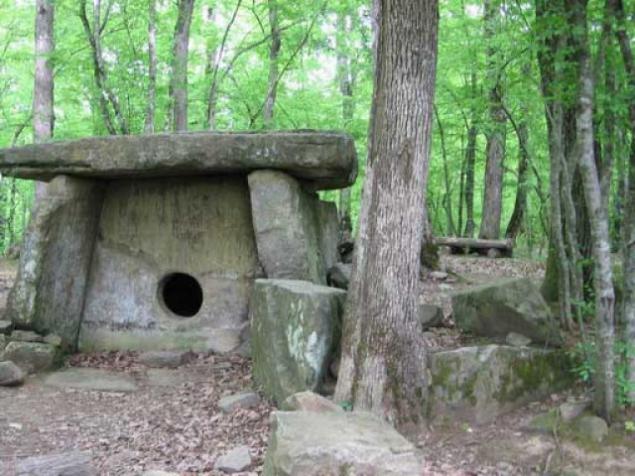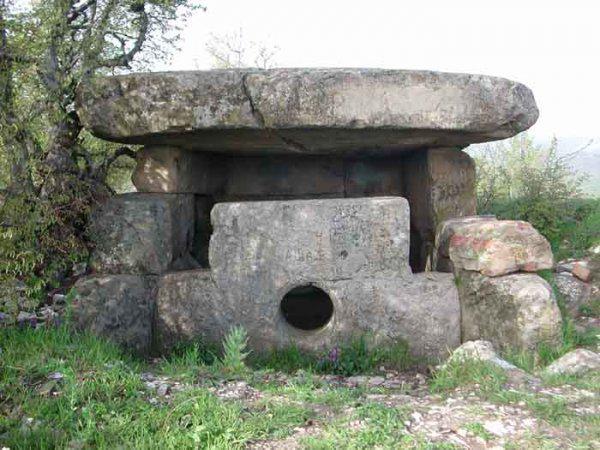574
About dolmens
WITH this post I want to know if any of those who do not YAPOVTSEV ONLY was next to dolmens, but also to feel or see anything unusual, and perhaps heal. WAIT OBJECTIVE COMMENTS
And if someone is not in the subject, here is the information:
Dolmen - a construction of five stone slabs with a round hole at the front of the stove, such as birdhouse, but mounted on the ground. The hole was closed carefully fitted stone cap-sleeve. This type of dolmen is typical for the Western Caucasus. Much less is there composite dolmens, when one or more boards are made up of smaller units. In the Caucasus, there are dolmens - polumonolity made of stone and covered with a huge plate-roof. Usually, by treating the surface around the hole, he was given the similarity with the front facade tile dolmen. Dolmens were constructed as monoliths in very limited quantities - carved entirely out of a single stone. Currently there is just one such dolmen in the Sochi region.
Dolmen Caucasus.
Average sizes dolmenov 2 m in width, 2 m in height and 3 m in length. The hole diameter of about 40 cm. The weight of each of the plates 3 to 8 tons, weight about 100 kg of cork. In the West Caucasus, they left about 2,000 pieces, including dolmens disintegrated. As many of them are no more than 20%.
But the very notion of a dolmen wider and also relates to the structures of the "stone table" or "bed giant", located in the coastal areas of the sea coasts of Europe, North Africa, the Middle and Far East, India and others. The time of their construction is dated by archaeologists from IV to II millennium BC The word "dolmen" comes from Breton (Celtic), the words «tolmen», which means tol table, and men - stone. Less common in other parts of the world there are "birdhouses».
The holes also vary from round to oval and even rectangular. But be sure each hole corresponds to the same shape stone tube hub.
The local population of the Caucasus, which the Circassians, the Circassians, Abkhazians and Karachai, there are several legends about the dolmens.
Circassians, for example, called them "ispui" or "spyun" - the dwarf house. Their legend has it that in ancient times lived the giants and dwarfs. Giants were big and often hurt dwarfs and midgets - small and tricky. Therefore, using cunning dwarfs giants were forced to build for themselves the dolmens of huge plates. In these houses, they feel safe. Dwarfs rode ua hares and Zaprygivayem to his home to them directly, through a hole in the front plate. The Cossacks were called dolmens BOGATYRSKY hut.
Archaeologists estimate the start of construction of some of the Caucasian dolmens, as the end of the third millennium BC. This means that the dolmen ancient pyramids! They regard them as burial structures, because they are the remains of graves of people.
But neither the builders dalmenov nor any of their contemporaries have left no record of the answers to our key questions.

WITH this post I want to know if any of those who do not YAPOVTSEV ONLY was next to dolmens, but also to feel or see anything unusual, and perhaps heal, waiting OBJECTIVE COMMENTS

More

More

Source:
And if someone is not in the subject, here is the information:
Dolmen - a construction of five stone slabs with a round hole at the front of the stove, such as birdhouse, but mounted on the ground. The hole was closed carefully fitted stone cap-sleeve. This type of dolmen is typical for the Western Caucasus. Much less is there composite dolmens, when one or more boards are made up of smaller units. In the Caucasus, there are dolmens - polumonolity made of stone and covered with a huge plate-roof. Usually, by treating the surface around the hole, he was given the similarity with the front facade tile dolmen. Dolmens were constructed as monoliths in very limited quantities - carved entirely out of a single stone. Currently there is just one such dolmen in the Sochi region.
Dolmen Caucasus.
Average sizes dolmenov 2 m in width, 2 m in height and 3 m in length. The hole diameter of about 40 cm. The weight of each of the plates 3 to 8 tons, weight about 100 kg of cork. In the West Caucasus, they left about 2,000 pieces, including dolmens disintegrated. As many of them are no more than 20%.
But the very notion of a dolmen wider and also relates to the structures of the "stone table" or "bed giant", located in the coastal areas of the sea coasts of Europe, North Africa, the Middle and Far East, India and others. The time of their construction is dated by archaeologists from IV to II millennium BC The word "dolmen" comes from Breton (Celtic), the words «tolmen», which means tol table, and men - stone. Less common in other parts of the world there are "birdhouses».
The holes also vary from round to oval and even rectangular. But be sure each hole corresponds to the same shape stone tube hub.
The local population of the Caucasus, which the Circassians, the Circassians, Abkhazians and Karachai, there are several legends about the dolmens.
Circassians, for example, called them "ispui" or "spyun" - the dwarf house. Their legend has it that in ancient times lived the giants and dwarfs. Giants were big and often hurt dwarfs and midgets - small and tricky. Therefore, using cunning dwarfs giants were forced to build for themselves the dolmens of huge plates. In these houses, they feel safe. Dwarfs rode ua hares and Zaprygivayem to his home to them directly, through a hole in the front plate. The Cossacks were called dolmens BOGATYRSKY hut.
Archaeologists estimate the start of construction of some of the Caucasian dolmens, as the end of the third millennium BC. This means that the dolmen ancient pyramids! They regard them as burial structures, because they are the remains of graves of people.
But neither the builders dalmenov nor any of their contemporaries have left no record of the answers to our key questions.

WITH this post I want to know if any of those who do not YAPOVTSEV ONLY was next to dolmens, but also to feel or see anything unusual, and perhaps heal, waiting OBJECTIVE COMMENTS

More

More

Source:






















